2.7 electric loading stretcher
3. Precautions for using stretcher
1.Introduction of stretcher
Speaking of stretchers, we all know that it is a tool that we all use in times of war, emergencies, or natural disasters. Without stretchers, it is very difficult for us to properly handle patients. The development of stretchers has a history of 100 years. With the development of material science and the establishment of emergency and disaster medicine models, the materials used for stretchers have been continuously improved. According to the requirements of modern war wound treatment, various special stretchers have also come out. Stretchers are also competing for development, forming a development situation with both unified standards and their own characteristics.
In daily life, the stretcher can not only be used to rescue patients in the hospital, but also used for military exercises. When disasters come, it can also be used to rescue the wounded, etc. The stretcher is widely used and plays an important role in our lives. At present, with the continuous development of the technical level, the stretcher has also become a necessary medical rescue supply for safety protection.
2.1 Portable emergency stretcher
A portable emergency stretcher is the basic type of stretcher. They are lightweight and portable and made of polyester or other synthetic materials.
Applicable scene:
Portable emergency stretchers are suitable for hospital first aid and can also be used to transport wild animals. This stretcher is sometimes used for disaster relief supplies. Carry a portable emergency stretcher with you when camping, hiking, hunting or medical assistance.
Features:
The portable emergency stretcher is suitable for storage and carrying.
The portable emergency stretcher is reasonably designed, comfortable and safe. The length and width of the portable emergency stretcher are suitable for wounded of any size. Equipped with simple straps and adjustable bandages, it is convenient to carry and prevent the wounded from falling during transportation.
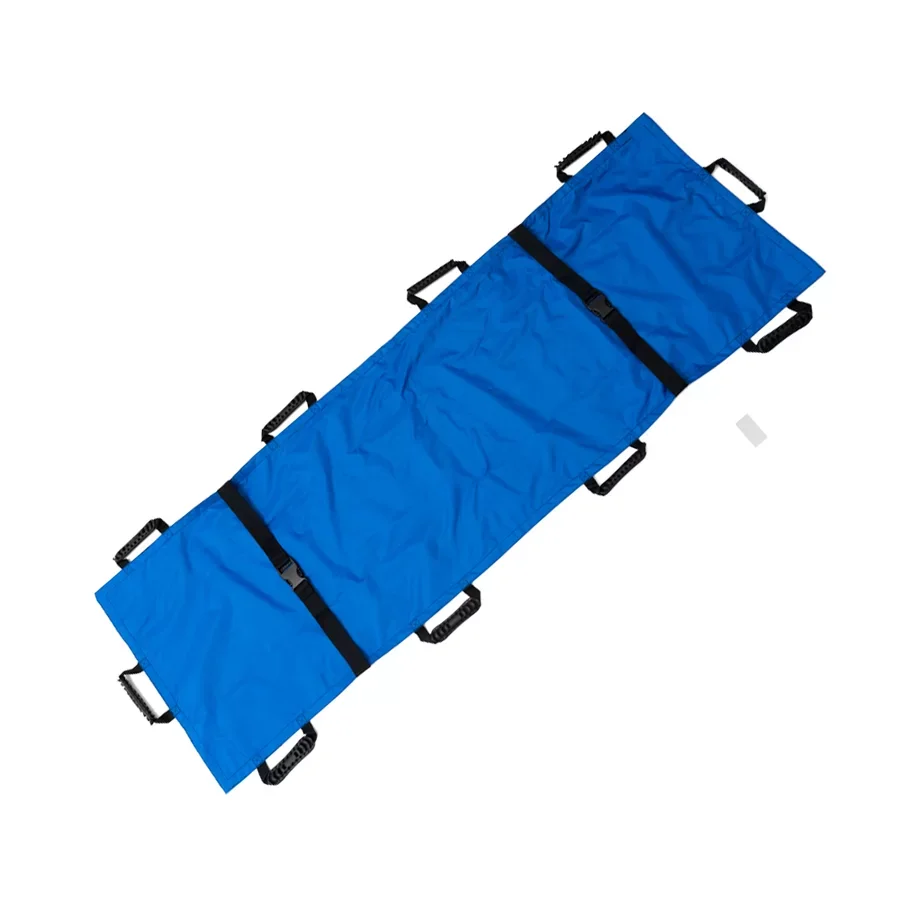
2.2 Fold up stretcher
The fold up stretcher is usually made of high-strength aluminum alloy material and oxford leather surface.
Applicable scene:
The fold up stretcher is suitable for the transportation of the wounded in the fire scene, the rescue of the traffic accident and the accident in the residential area, etc.
Features:
The fold up stretcher has the characteristics of light weight, small size, safe use and easy portability, which greatly improves the rescue efficiency.
The connecting rod, telescopic rod, movable plate and fixed plate of the fold up stretcher are all made of high-strength powder coated aluminum alloy materials, which are sturdy and durable, have anti-rust, anti-corrosion and moth-proof functions, and have reliable anti-extrusion and weight load functions.
The frame of the fold up stretcher is strong and durable, and the device is simple and reliable, enabling the operator to take first aid measures safely and quickly.
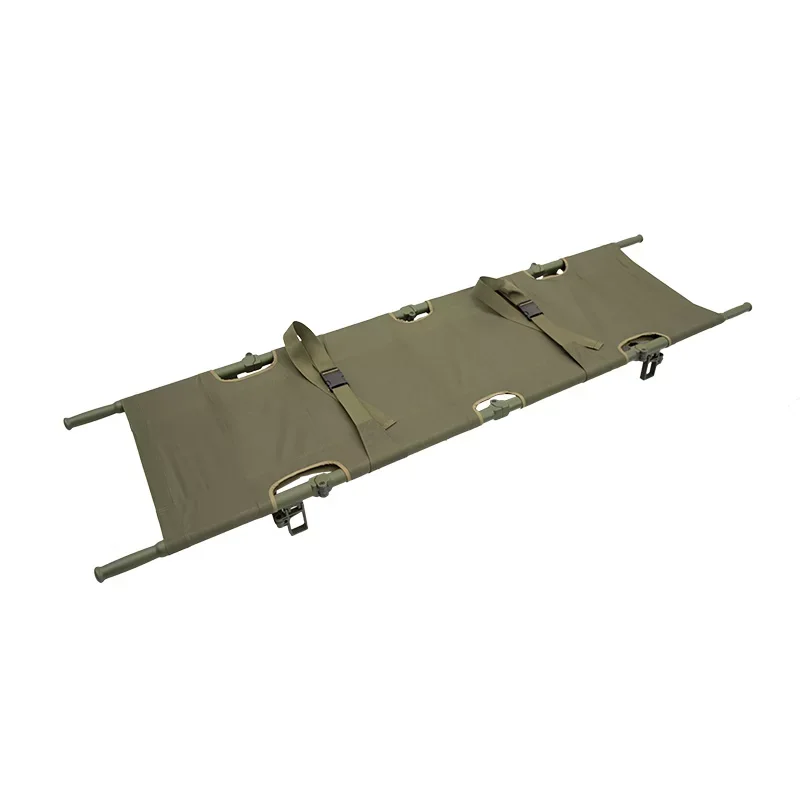
Instructions:
Open the foldable stretcher, straighten the bar below the stretcher, and spread the stretcher canvas completely.
The three stretcher truckriers kneel side by side with one leg on the side of the injured person, and at the same time stretch their arms into the shoulders, back, abdomen and buttocks, and under the lower limbs of the injured person, and then stand up at the same time, keeping the injured body in a horizontal position and not twisted at all times.
The three of them took steps at the same time and placed the wounded on a fold up stretcher at the same time.
If it is a cervical spine injury, another person should be assigned to be responsible for traction and fixation of the head and neck. The four people must move in the same way, lift the wounded up flat, and then put him on the fold up stretcher at the same time.
In the process of standing up, walking, putting down, etc., a medical staff should command and all staff make unified actions.
The carriers can also have one leg on both sides of the wounded, one person on one side is responsible for the waist and buttocks of the wounded lying on the stretcher, and two people on the other side are respectively responsible for the shoulders, back and lower limbs, so that the wounded body is always kept horizontal position without twisting the body.
2.3 Scoop stretcher
Generally speaking, scoop stretchers can be divided into aluminum scoop stretchers, carbon fiber scoop stretchers and plastic scoop stretchers.
The aluminum alloy scoop stretcher is composed of two aluminum alloy plates on the left and right, which is sturdy and durable.
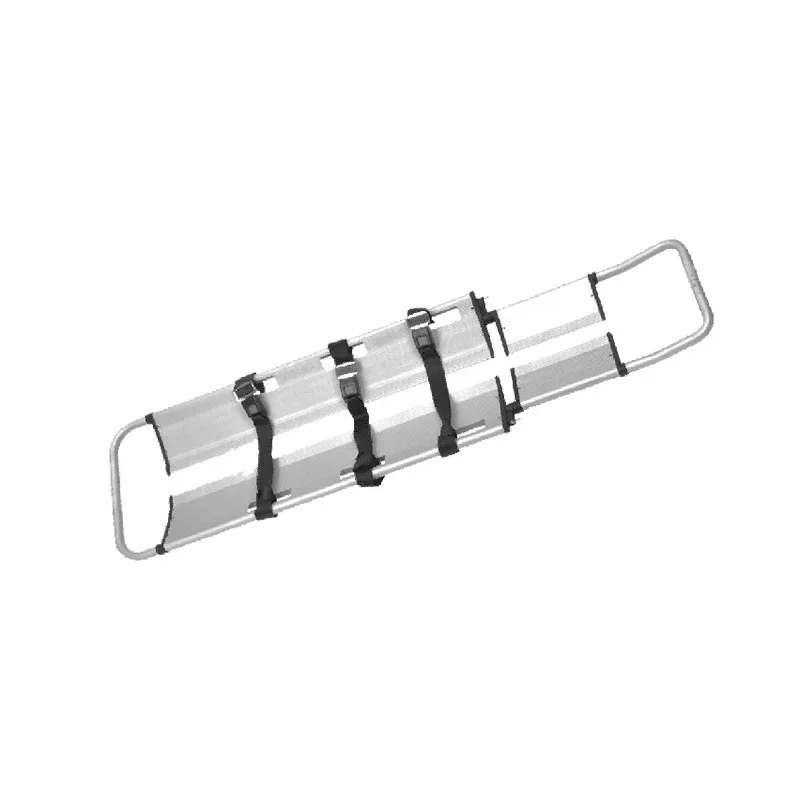
The carbon fiber scoop stretcher is light in weight and more convenient to carry. The carbon fiber scoop stretcher subverts the material application of the traditional emergency scoop stretcher, and realizes the combination of material innovation and practicality of the scoop stretcher in emergency rescue.
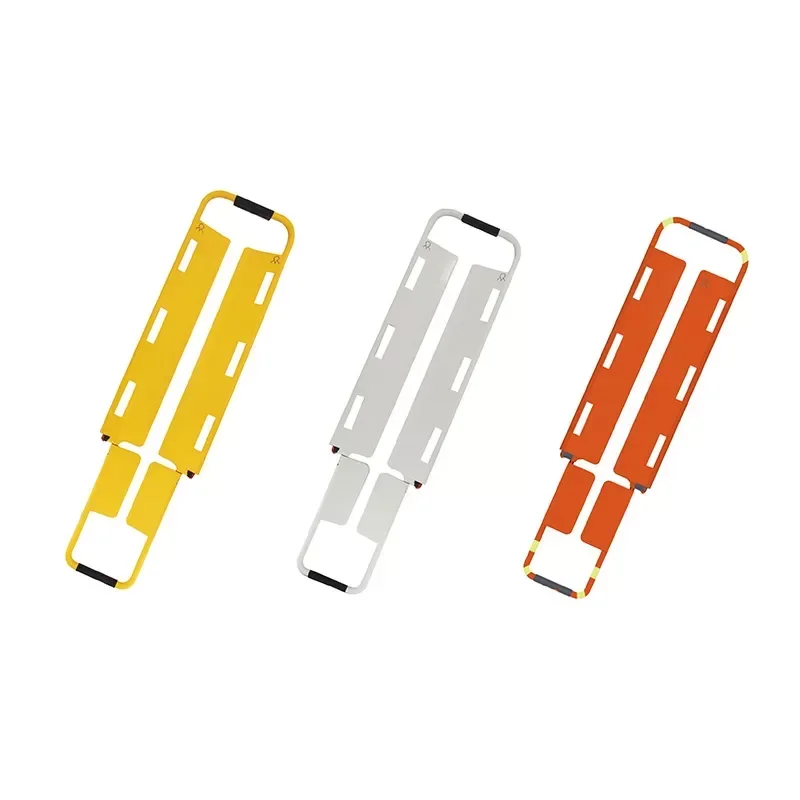
Plastic scoop stretchers are generally made of high-density plastic and are easy to assemble and disassemble.

Applicable scene:
Scoop stretchers are mainly used in ambulances, hospitals and emergency centers.
Features:
No matter what kind of scoop stretcher is used, it can ensure that the patient can be quickly shoveled in without moving the patient, so as to avoid secondary injury to the patient.
The length of the scoop stretcher can be adjusted according to the actual height of the patient, and it can be folded, which minimizes the size of the stretcher and is easy to place and carry.
The plastic scoop stretcher is made of lightweight material and can be used to lift, transfer and transport patients.
The scoop stretcher can be equipped with straps, which can fix the patient's head, providing favorable conditions for the stable placement of the patient and the fixation of the injured part.
Compared with the traditional method, the scoop stretcher has an irreplaceable role in reducing the patient's pain, increasing the patient's satisfaction, reducing the occurrence of re-injury, shortening the handling time, and improving work efficiency in the process of emergency handling.Handling method:
When using a scoop stretcher to transport the wounded, first place the wounded in a supine position, fix the neck, and then insert the left and right pieces of the stretcher into the back of the wounded from the side, and then fasten them before carrying.
The scoop stretcher is simple and convenient to use and easy to master. It is not necessary to move the whole body away from the stretcher surface during patient transportation, which not only saves manpower, but also is relatively safe, reduces complications during transportation, and is worthy of clinical promotion and use.
With obese patients, it is possible to accidentally pinch the patient's back when closing the stretcher, so care must be taken not to injure them during operation.
2.4 Basket Stretcher
Basket stretchers are also called boat stretchers. There are two common types on the market: aluminum alloy basket stretchers and synthetic resin basket stretchers. The shape of the basket stretcher is very similar to its name, like a "boat". When transporting the trapped people, the trapped people are placed in the basket stretcher, and the stretcher has "protruding" edges around it and the webbing on the front to "enclose" the trapped people inside the stretcher. In this way, the trapped person will not be released from the stretcher due to the displacement of the stretcher (such as flipping, shaking).
Applicable scene:
Basket stretchers are suitable for first aid in special situations, such as mountain, air or sea rescue.
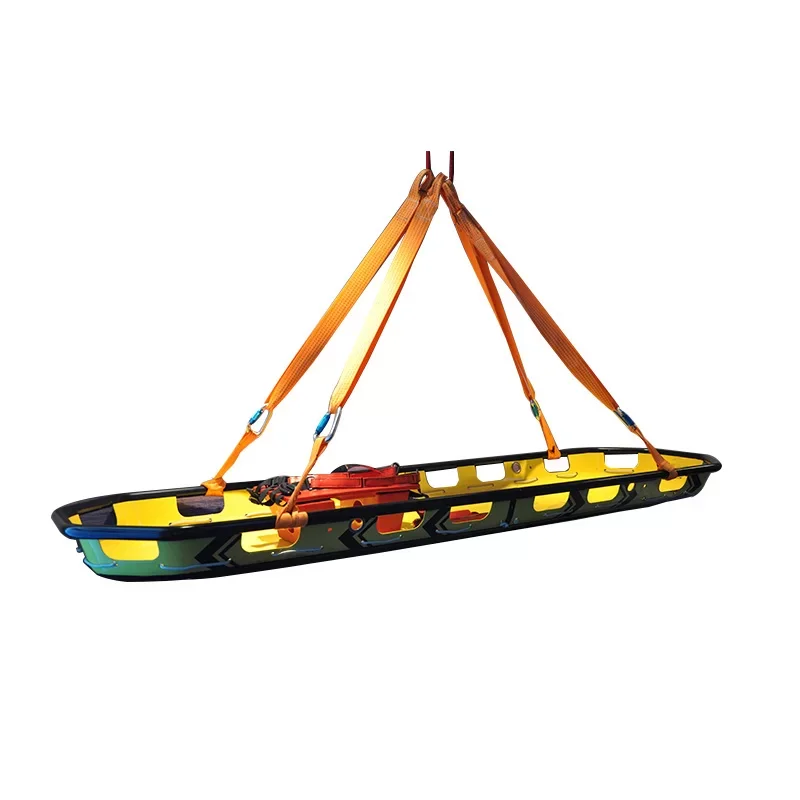
Features:
The basket stretcher can be used to fix the head, waist, legs and feet of the injured patient at sea or in the field, and the corresponding adjustment device can be adjusted in a targeted manner to achieve the purpose of immobilizing the injured patient. It is handled by ambulance personnel under different environmental conditions.
The basket stretcher can disassemble the seat belt according to the injured part of the injured patient, and find a suitable position to fix it; it is convenient for rescue personnel to carry it under different environmental conditions.
The hook suspension of the basket stretcher can be connected with the hook on the plane to realize field rescue.
The simple and reliable device of the basket stretcher allows the operator to take first aid measures safely and quickly.
2.5 Isolation stretcher
The isolation stretcher is an integration of the emergency stretcher and the isolation cabin for infectious patients, and their organic combination achieves multi-functional purposes. The isolation stretcher is made of high-quality durable transparent plastic with a sealed zipper.
Applicable scene:
(1) In the customs, stations, airports, harbors, and other public places where people gather, the isolation stretcher can be used as emergency isolation equipment after infectious patients and suspected patients are found, allowing patients or suspected patients to enter the stretcher easily and quickly and moved quickly to a relatively safe place. To achieve the purpose of "closing" the source of infection and completely isolating infectious patients from susceptible people in a timely and effective manner.
(2) When it is necessary to urgently transport infected patients found in mobile sites or communities to medical institutions or stations, airports, and ports, isolation stretchers can be used as closed means of transportation. It’s convenient for short-distance transport, or transporting infectious patients on emergency vehicle transport equipment and help avoid the spread of germs to escorts and those who are in contact on the way, and protect other groups from infection.
(3) In the case of temporarily unconditionally sending infectious patients or suspected patients to hospitals and disposal sites, the isolation stretcher can be used as a temporary detention space, providing a temporary detention and isolation platform for them, waiting for the next step. The stretcher is directly placed on the vehicle, ship and plane, and used as an isolation device. The self-contained charging power supply of the isolation stretcher can ensure the normal filtration and ventilation of the stretcher isolation cabin and the activities of the patients in the cabin within 6 hours. The safety care gloves on the bulkhead can also be used for necessary disposal.

Precautions for use:
(1) The used isolation stretcher should be cleaned and disinfected in time.
(2) Please store the isolation stretcher in a cool and dry place.
(3) Pay attention to charging in time before backup and use. Please calculate the time after the power is off, and charge the isolation stretcher in time after use.
(4) When the filter membrane of the air inlet becomes dirty, please replace it with a new filter membrane in time.
(5) After using for a period of time, when it is found that there is no negative pressure in the isolation chamber, please replace the high-efficiency filter of the exhaust system. The isolation stretcher cannot be exposed to sunlight, wind or rain for a long time, and should be stored in a cool place. Keep the negative pressure isolation stretcher clean.
(6) Please be careful when disassembling and installing the isolation stretcher, so as not to scratch the enclosure structure of the negative pressure isolation cabin.
(7) When transporting infectious patients, please do not open the zipper of the patient's entrance at will, so as to avoid the leakage of the disease source.
2.6 Stretcher truck
The stretcher truck is also known as the ambulance stretcher truck, the ambulance stretcher.
Applicable scene:
It is suitable for transporting the wounded and sick in ambulances, hospitals, battlefields and gymnasiums.
Instructions:
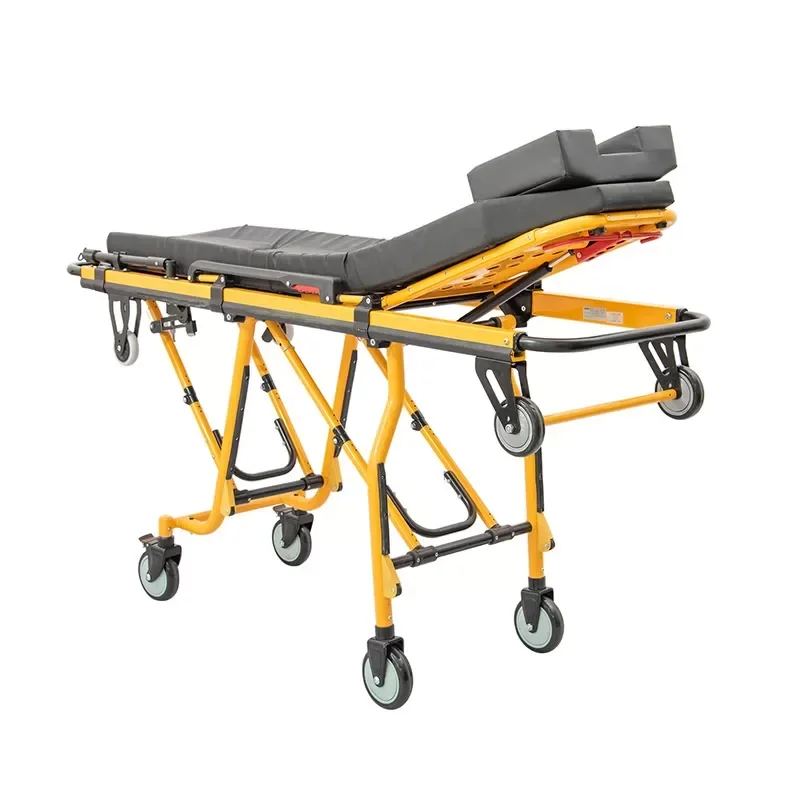
(1) The stretcher truck adopts a sponge pad stretcher machine to make the patient transport comfortable when lifting the patient on the stretcher and transporting it by ambulance.
(2) If the head of the stretcher needs to be raised, press the button under the head of the stretcher to lift it upward.
(3) After transporting the patient to the ward or destination, pull out the handle, and two people can lift it down.
(4) The guardrail of the stretcher truck adopts a rotary elastic locking device, and the guardrail is turned up to ensure the safety of the patient. If necessary, the safety belt is used for insurance; when the guardrail is turned down, it is convenient for the patient to get up and down.
(5) When the patient needs infusion, one end of the stretcher truck can be inserted into the infusion frame.
2.7 Electric loading stretcher
The electric loading stretcher adopts a scientific structural frame as a whole, with beautiful appearance and large bearing capacity. It can be transported on the sidewalk more easily and the patient can be secured with straps during transport.
Applicable scene:
Suitable for emergency transport in hospitals.

Feature:
The electric loading stretcher is easy to operate and greatly reduces the labor intensity of medical staff.
The height of the electric loading stretcher can be adjusted freely and can be matched with the height of the hospital bed, which can quickly and conveniently transport the injured to the ambulance.
The backrest, the thigh plate and the hip plate of the electric loading stretcher can be folded, so that it is convenient for patients with injuries in different parts to use the stretcher. The head of the stretcher can be raised to place the patient in a seated position (especially important for patients in respiratory distress) or flattened for CPR, or for patients with suspected spinal injuries that must be transported with a spinal board. The patient's foot can be elevated into the so-called Trendelenburg position, which is suitable for the wounded in shock.
2.8 Stair Chair Stretcher
Generally, traditional wheelchairs are not suitable for climbing stairs, they have many limitations, but stair chair stretchers can solve this problem very well. The stair chair stretcher allows caregivers to easily carry patients up and down stairs.
Applicable scene:
The stair chair stretcher is mainly used for transfer, emergency rescue, and is suitable for transferring patients up and down stairs. It is a medical manual patient transport device specially provided for patients who are inconvenient to walk before and after surgery.
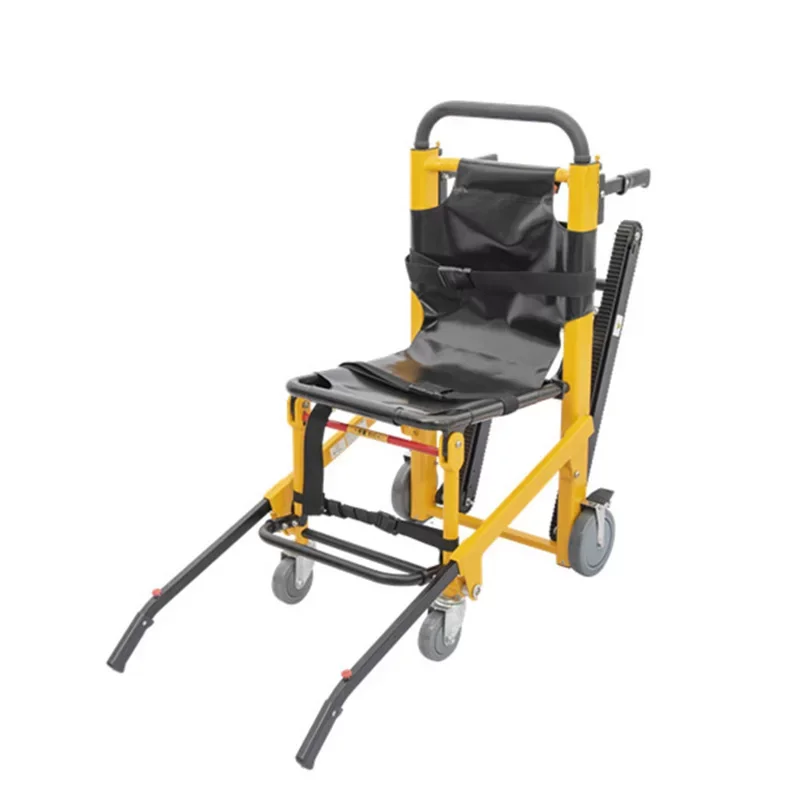
Feature:
For the safety of the user, body straps are provided on the chair for stability.
The stair chair stretcher is made of aluminum alloy, which is light in weight and easy to carry. They are foldable and take up less space.
2.9 Spine board stretcher
Spinal board stretcher is also known as spinal fixation board and board stretcher. Spinal fixation board is specially used when transporting people with spinal injuries. It adopts high-density polyethylene shell, and X-rays can penetrate 100%. The external fixation device can better protect the back of the injured person.
Applicable scene:
It is suitable for transporting the wounded and sick in sports venues, ambulances and battlefields, and the foam-filled spine board stretcher is also suitable for water rescue.
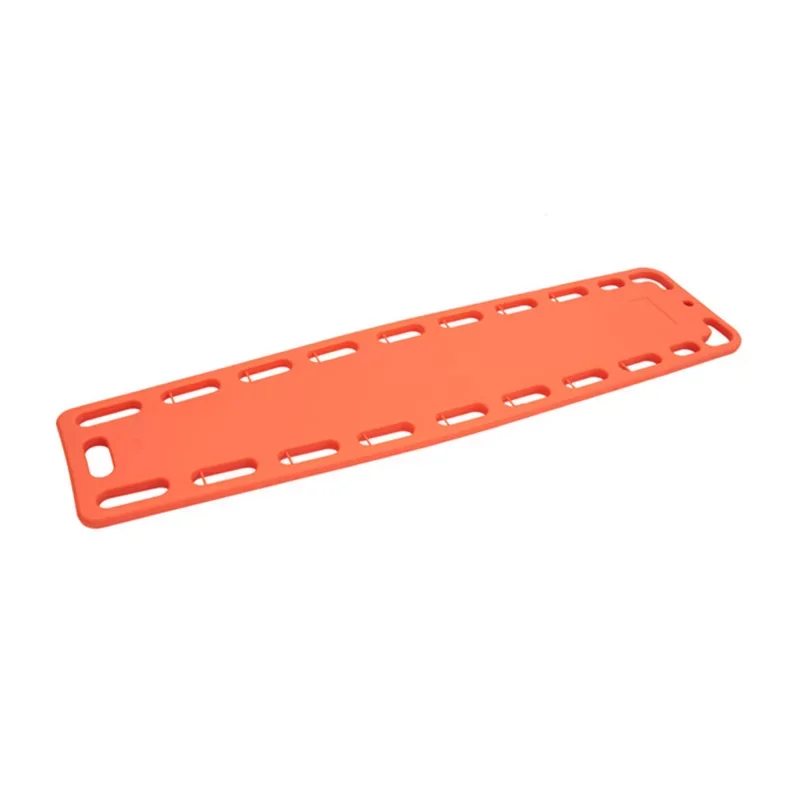
Instructions:
When using a spinal board stretcher, the patient's upper limbs should be attached to both sides of the torso, and the lower limbs should be brought together;
The patient should be carried by at least 2 people. Do not use the "crane-type" method of carrying one person holding the chest and one person holding the legs.
Patients suspected of cervical spine injury need at least 3 people to carry. For patients who are suspected of having cervical spine fractures, the nursing staff should first kneel by the side of the top of the injured person's head, fix the patient's head with the "head lock" technique, and at the same time pull the patient's head upward with even and moderate force to adjust the patient's head position.
In principle, the patient's head position should be adjusted so that the tip of the nose is on the midline and the mandible is raised. Then a cervical collar should be used to immobilize the patient's cervical spine.
Place the spine board stretcher directly under the back of the patient, fix the head to the spine board with a head immobilizer, and fix the trunk and limbs with the restraint straps attached to the spine board to ensure that the head, neck, trunk, and pelvis are all fixed on the same straight line .
Spinal immobilization must be maintained during handling to avoid spinal cord injury caused or aggravated by abnormal movement of the fracture site.
In the emergency process of using the spine board stretcher to carry patients, emergency nurses should also work together, and the method must be appropriate, otherwise it will lead to serious consequences.
3. Precautions for using stretcher
(1) Check the wounded
Before transporting the wounded, check the wounded's vital signs and injured parts, focusing on checking whether the wounded's head, spine, and chest have trauma, especially whether the cervical spine is injured.
(2) The wounded must be properly handled
First, keep the airway of the injured person unobstructed, and then stop the bleeding, bandage, and fix the injured part of the wounded according to the technical operation specifications. It can only be moved after proper handling.
(3) Do not carry the personnel or stretchers when they are not ready.
Be comprehensive when handling overweight and delirious casualties. You can choose to use electric loading stretchers, basket stretchers, etc. for transportation. At the same time, it is necessary to prevent accidents such as falls and injuries during transportation.
(4) During the transportation process, the changes in the condition of the wounded should be observed at any time.
Focus on observing breathing, consciousness, etc., of the wounded, pay attention to keep him warm, but do not cover the head and face too tightly, so as not to affect breathing. In the event of an emergency situation on the way, such as suffocation, respiratory arrest, convulsions, stop handling and conduct first aid immediately.
(5 )In a special site, it should be handled according to a special method.
At the scene of the fire, when transporting the wounded in the thick smoke, the rescue staff should bend over or crawl forward; at the scene of the leakage of toxic gas, the transporter should first cover the mouth and nose with a wet towel or use a gas mask to avoid being fumigated by the gas.
During the transportation of the wounded, the wounded must be turned every half an hour. For the paraplegic and the wounded with extensive burns, a soft stretcher can be used to cover it and fasten it with a strap, and then the wounded will be turned over in one direction.
After the casualty is turned over, massage the skin of the protruding part. When marching, the head of the wounded should be placed behind and the feet at the front, so as to observe the facial expressions and breathing of the wounded.
(6) Carrying the injured of the spine and spinal cord injury:
After being placed on the spine board stretcher, the body and the stretcher must be firmly fixed with a triangle towel or other cloth strips, especially for those with cervical spine injuries, sandbags, pillows, clothing, etc. must be placed on both sides of the head and neck for fixation to limit the cervical spine. Then use a triangle towel to fix the forehead together with the stretcher, and then use a triangle towel to surround the whole body with the stretcher.
(7) Pay attention to the effect of weather on the wounded
When transporting the wounded on a stretcher in cold conditions, attention should be paid to keeping him warm. Hot water bottles and military water bottles can be placed in the quilt. When transporting the wounded on a stretcher in the rainy season at night, cover the wounded with a rain cloth to prevent the wounded from getting wet in the rain. When transporting the wounded under hot conditions, the wounded should be protected from the sun to prevent heat stroke. During the transportation, the changes of the wounded's condition should be continuously observed, and pressure bandaging should be applied to stop the bleeding the wounds.
4. Relevant suggestions
https://www.yearstar-care.com/medical-emergency-stretcher.html
https://www.yearstar-care.com/Advantages-of-medical-aluminum-alloy-scoop-stretcher.html
https://www.yearstar-care.com/multifunctional-folding-stretcher.html










Comments (0)